Wireless Sensor Network for Pipeline Leak Detection Project
VerifiedAdded on 2020/03/15
|20
|2992
|136
Project
AI Summary
This project investigates the application of a wireless sensor network (WSN) for leak detection in pipelines. The project outlines the problem, objectives, and methodology, which relies on quantitative data from internet and library sources. It details the types of wireless communication, including infrared and broadcast radio, and explains pipeline transport and various leak detection systems, such as direct and inferential methods. The project then delves into telecommunication principles, including basic elements, block diagrams, and circuit diagrams, explaining the function of components like sensors, microcontrollers, and transmitters/receivers. It also covers modulation and demodulation techniques and the characteristics of WSNs, concluding with recommendations for future work. The system uses sensors to detect leaks, sending data to a microcontroller that processes the results and transmits them to a base station, which indicates the presence of a leak. The project includes circuit diagrams and flowcharts, detailing the process of data transmission and analysis within the network.
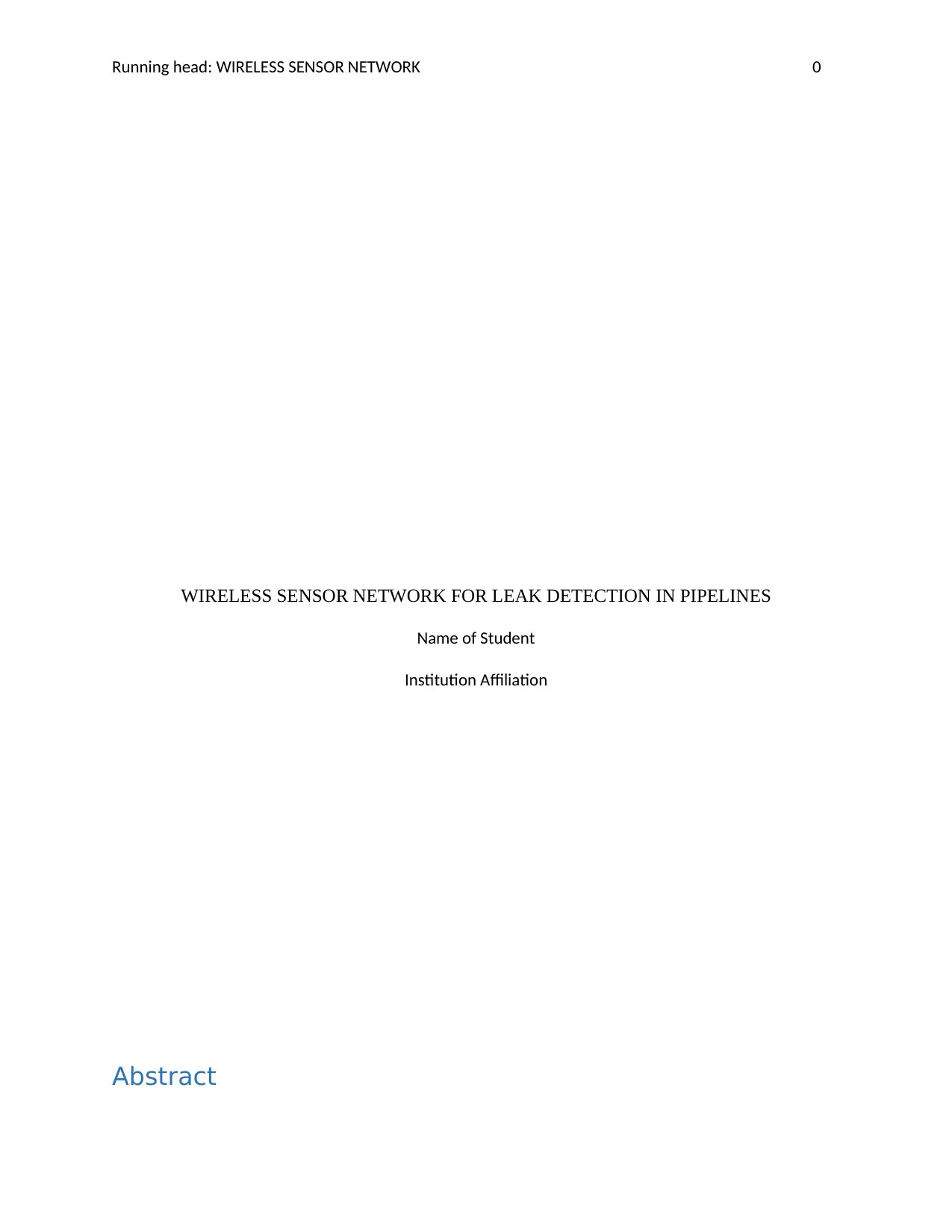
Running head: WIRELESS SENSOR NETWORK 0
WIRELESS SENSOR NETWORK FOR LEAK DETECTION IN PIPELINES
Name of Student
Institution Affiliation
Abstract
WIRELESS SENSOR NETWORK FOR LEAK DETECTION IN PIPELINES
Name of Student
Institution Affiliation
Abstract
Paraphrase This Document
Need a fresh take? Get an instant paraphrase of this document with our AI Paraphraser
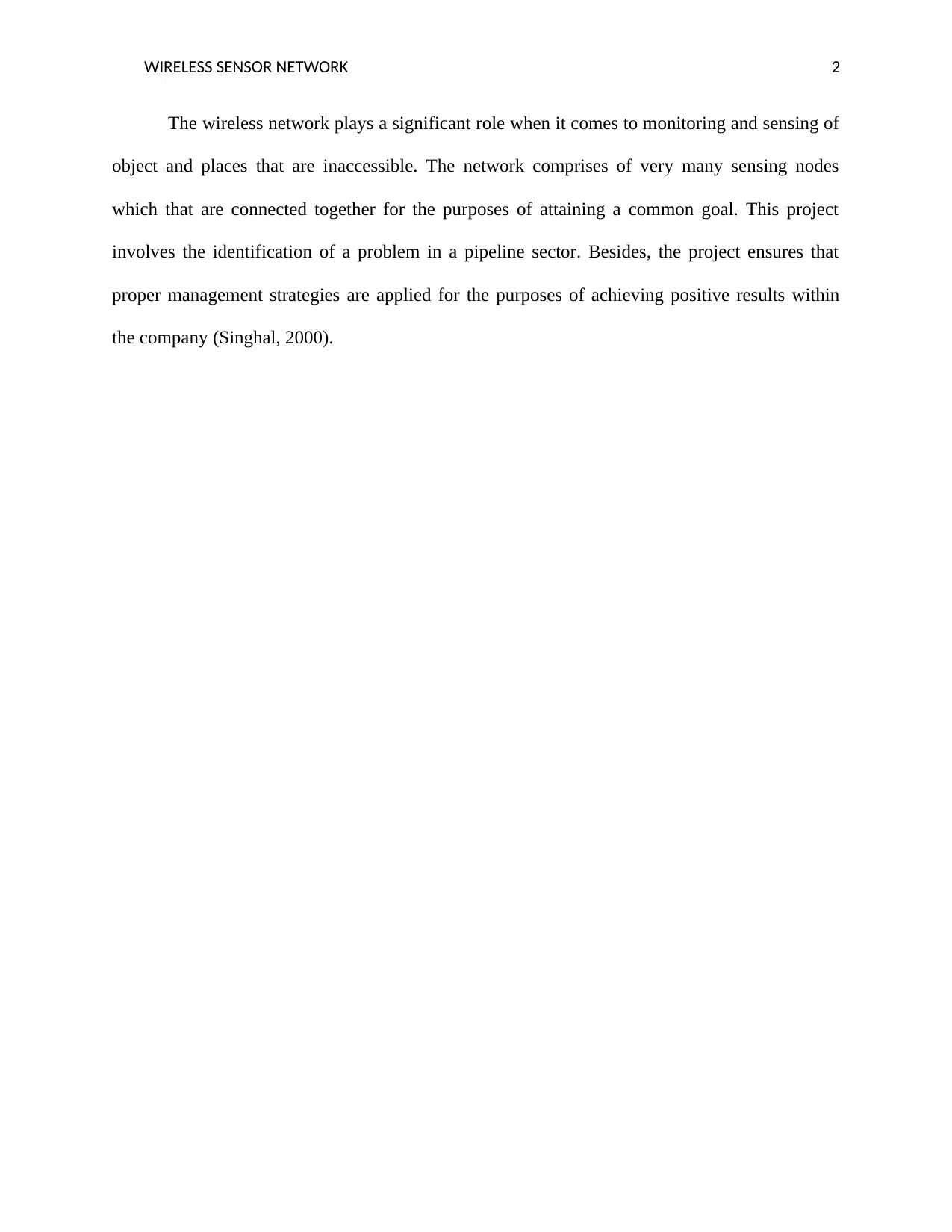
WIRELESS SENSOR NETWORK 2
The wireless network plays a significant role when it comes to monitoring and sensing of
object and places that are inaccessible. The network comprises of very many sensing nodes
which that are connected together for the purposes of attaining a common goal. This project
involves the identification of a problem in a pipeline sector. Besides, the project ensures that
proper management strategies are applied for the purposes of achieving positive results within
the company (Singhal, 2000).
The wireless network plays a significant role when it comes to monitoring and sensing of
object and places that are inaccessible. The network comprises of very many sensing nodes
which that are connected together for the purposes of attaining a common goal. This project
involves the identification of a problem in a pipeline sector. Besides, the project ensures that
proper management strategies are applied for the purposes of achieving positive results within
the company (Singhal, 2000).
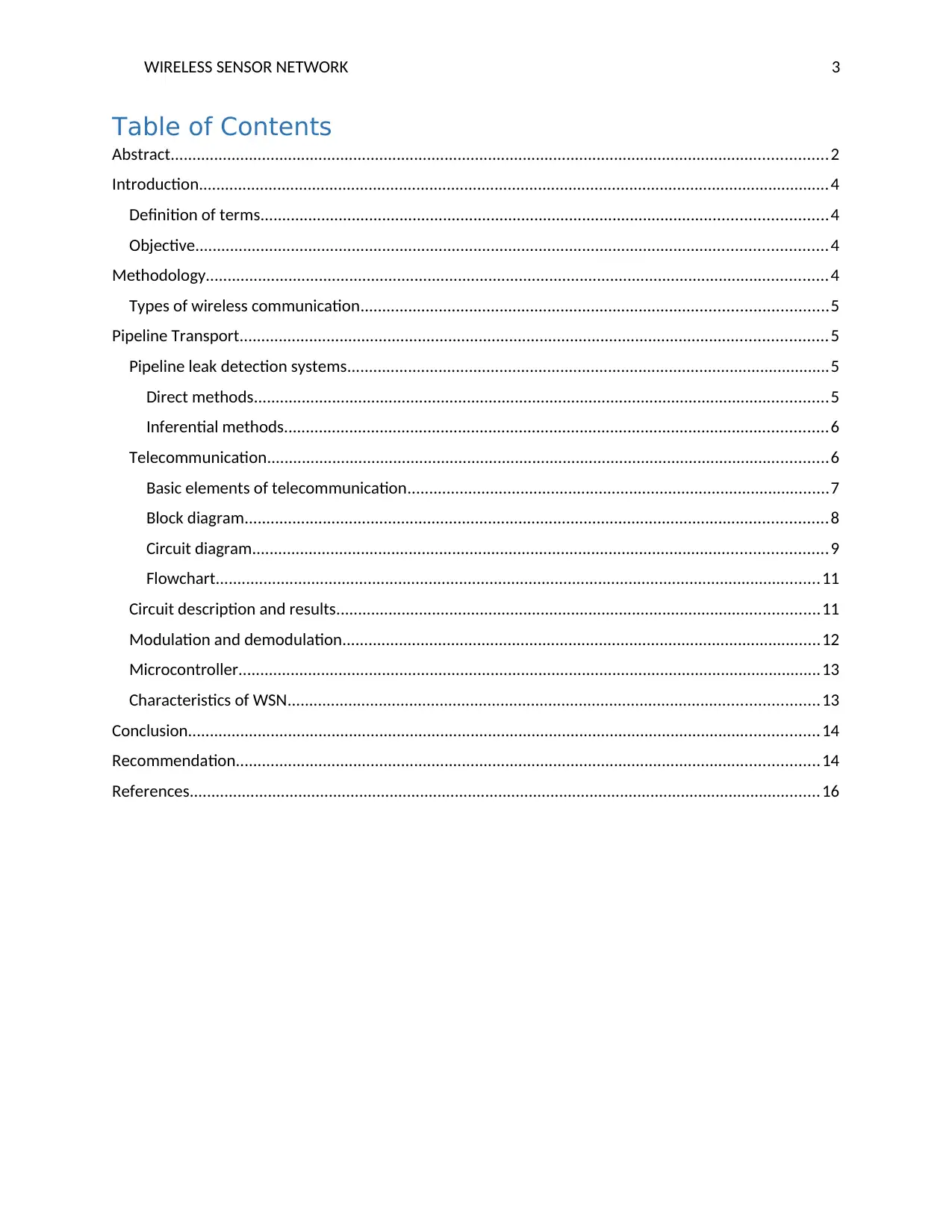
WIRELESS SENSOR NETWORK 3
Table of Contents
Abstract.......................................................................................................................................................2
Introduction.................................................................................................................................................4
Definition of terms..................................................................................................................................4
Objective.................................................................................................................................................4
Methodology...............................................................................................................................................4
Types of wireless communication...........................................................................................................5
Pipeline Transport.......................................................................................................................................5
Pipeline leak detection systems...............................................................................................................5
Direct methods....................................................................................................................................5
Inferential methods.............................................................................................................................6
Telecommunication.................................................................................................................................6
Basic elements of telecommunication.................................................................................................7
Block diagram......................................................................................................................................8
Circuit diagram....................................................................................................................................9
Flowchart...........................................................................................................................................11
Circuit description and results...............................................................................................................11
Modulation and demodulation..............................................................................................................12
Microcontroller......................................................................................................................................13
Characteristics of WSN..........................................................................................................................13
Conclusion.................................................................................................................................................14
Recommendation......................................................................................................................................14
References.................................................................................................................................................16
Table of Contents
Abstract.......................................................................................................................................................2
Introduction.................................................................................................................................................4
Definition of terms..................................................................................................................................4
Objective.................................................................................................................................................4
Methodology...............................................................................................................................................4
Types of wireless communication...........................................................................................................5
Pipeline Transport.......................................................................................................................................5
Pipeline leak detection systems...............................................................................................................5
Direct methods....................................................................................................................................5
Inferential methods.............................................................................................................................6
Telecommunication.................................................................................................................................6
Basic elements of telecommunication.................................................................................................7
Block diagram......................................................................................................................................8
Circuit diagram....................................................................................................................................9
Flowchart...........................................................................................................................................11
Circuit description and results...............................................................................................................11
Modulation and demodulation..............................................................................................................12
Microcontroller......................................................................................................................................13
Characteristics of WSN..........................................................................................................................13
Conclusion.................................................................................................................................................14
Recommendation......................................................................................................................................14
References.................................................................................................................................................16
⊘ This is a preview!⊘
Do you want full access?
Subscribe today to unlock all pages.

Trusted by 1+ million students worldwide
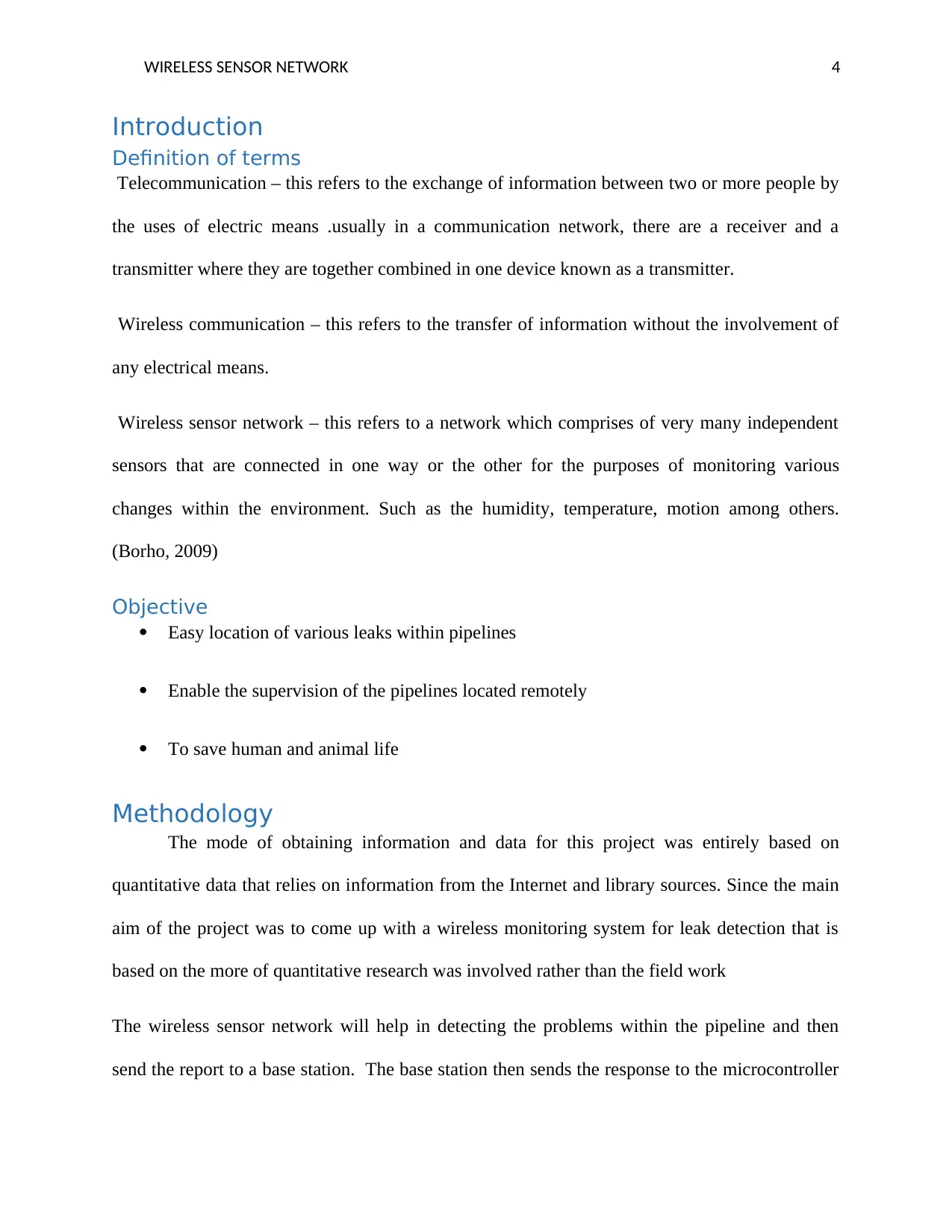
WIRELESS SENSOR NETWORK 4
Introduction
Definition of terms
Telecommunication – this refers to the exchange of information between two or more people by
the uses of electric means .usually in a communication network, there are a receiver and a
transmitter where they are together combined in one device known as a transmitter.
Wireless communication – this refers to the transfer of information without the involvement of
any electrical means.
Wireless sensor network – this refers to a network which comprises of very many independent
sensors that are connected in one way or the other for the purposes of monitoring various
changes within the environment. Such as the humidity, temperature, motion among others.
(Borho, 2009)
Objective
Easy location of various leaks within pipelines
Enable the supervision of the pipelines located remotely
To save human and animal life
Methodology
The mode of obtaining information and data for this project was entirely based on
quantitative data that relies on information from the Internet and library sources. Since the main
aim of the project was to come up with a wireless monitoring system for leak detection that is
based on the more of quantitative research was involved rather than the field work
The wireless sensor network will help in detecting the problems within the pipeline and then
send the report to a base station. The base station then sends the response to the microcontroller
Introduction
Definition of terms
Telecommunication – this refers to the exchange of information between two or more people by
the uses of electric means .usually in a communication network, there are a receiver and a
transmitter where they are together combined in one device known as a transmitter.
Wireless communication – this refers to the transfer of information without the involvement of
any electrical means.
Wireless sensor network – this refers to a network which comprises of very many independent
sensors that are connected in one way or the other for the purposes of monitoring various
changes within the environment. Such as the humidity, temperature, motion among others.
(Borho, 2009)
Objective
Easy location of various leaks within pipelines
Enable the supervision of the pipelines located remotely
To save human and animal life
Methodology
The mode of obtaining information and data for this project was entirely based on
quantitative data that relies on information from the Internet and library sources. Since the main
aim of the project was to come up with a wireless monitoring system for leak detection that is
based on the more of quantitative research was involved rather than the field work
The wireless sensor network will help in detecting the problems within the pipeline and then
send the report to a base station. The base station then sends the response to the microcontroller
Paraphrase This Document
Need a fresh take? Get an instant paraphrase of this document with our AI Paraphraser
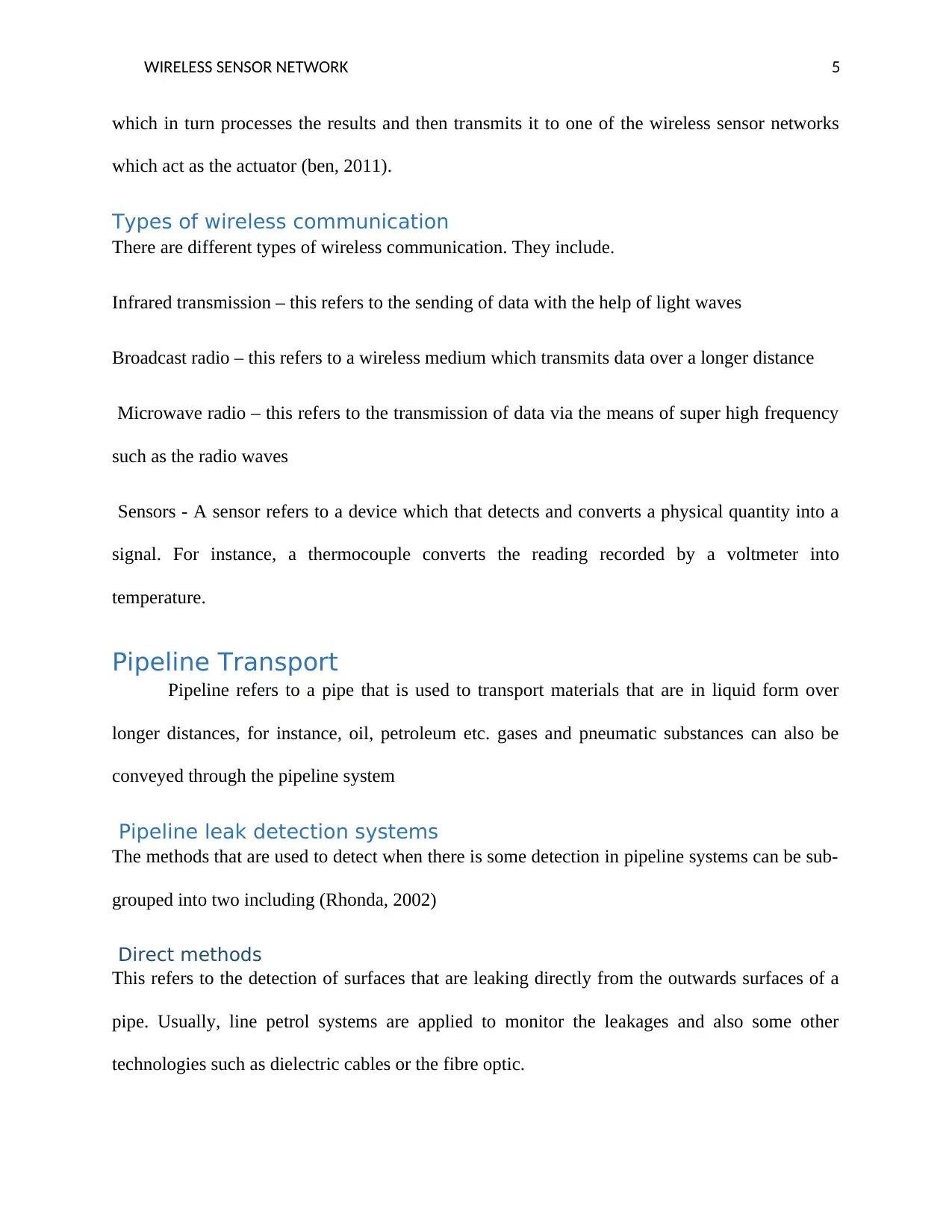
WIRELESS SENSOR NETWORK 5
which in turn processes the results and then transmits it to one of the wireless sensor networks
which act as the actuator (ben, 2011).
Types of wireless communication
There are different types of wireless communication. They include.
Infrared transmission – this refers to the sending of data with the help of light waves
Broadcast radio – this refers to a wireless medium which transmits data over a longer distance
Microwave radio – this refers to the transmission of data via the means of super high frequency
such as the radio waves
Sensors - A sensor refers to a device which that detects and converts a physical quantity into a
signal. For instance, a thermocouple converts the reading recorded by a voltmeter into
temperature.
Pipeline Transport
Pipeline refers to a pipe that is used to transport materials that are in liquid form over
longer distances, for instance, oil, petroleum etc. gases and pneumatic substances can also be
conveyed through the pipeline system
Pipeline leak detection systems
The methods that are used to detect when there is some detection in pipeline systems can be sub-
grouped into two including (Rhonda, 2002)
Direct methods
This refers to the detection of surfaces that are leaking directly from the outwards surfaces of a
pipe. Usually, line petrol systems are applied to monitor the leakages and also some other
technologies such as dielectric cables or the fibre optic.
which in turn processes the results and then transmits it to one of the wireless sensor networks
which act as the actuator (ben, 2011).
Types of wireless communication
There are different types of wireless communication. They include.
Infrared transmission – this refers to the sending of data with the help of light waves
Broadcast radio – this refers to a wireless medium which transmits data over a longer distance
Microwave radio – this refers to the transmission of data via the means of super high frequency
such as the radio waves
Sensors - A sensor refers to a device which that detects and converts a physical quantity into a
signal. For instance, a thermocouple converts the reading recorded by a voltmeter into
temperature.
Pipeline Transport
Pipeline refers to a pipe that is used to transport materials that are in liquid form over
longer distances, for instance, oil, petroleum etc. gases and pneumatic substances can also be
conveyed through the pipeline system
Pipeline leak detection systems
The methods that are used to detect when there is some detection in pipeline systems can be sub-
grouped into two including (Rhonda, 2002)
Direct methods
This refers to the detection of surfaces that are leaking directly from the outwards surfaces of a
pipe. Usually, line petrol systems are applied to monitor the leakages and also some other
technologies such as dielectric cables or the fibre optic.
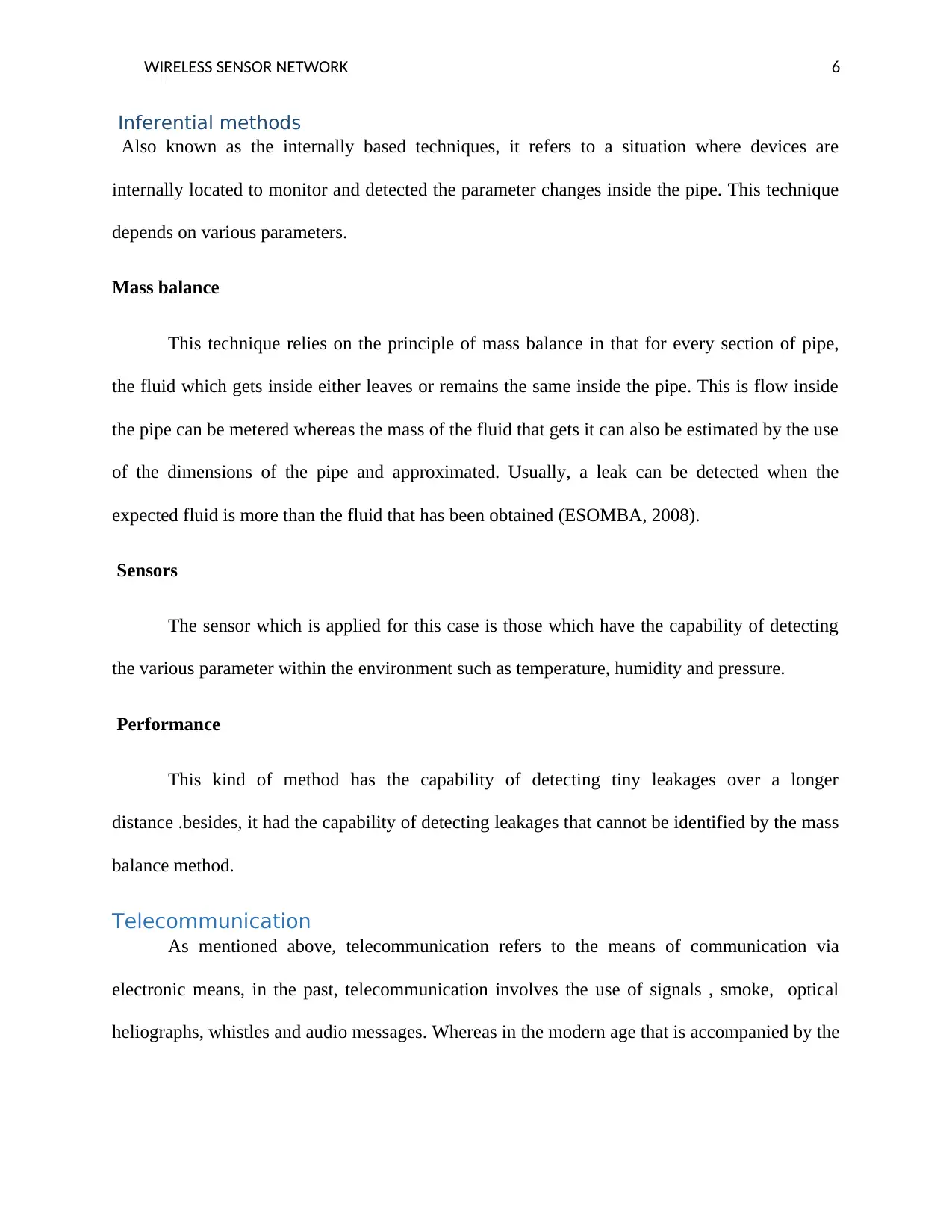
WIRELESS SENSOR NETWORK 6
Inferential methods
Also known as the internally based techniques, it refers to a situation where devices are
internally located to monitor and detected the parameter changes inside the pipe. This technique
depends on various parameters.
Mass balance
This technique relies on the principle of mass balance in that for every section of pipe,
the fluid which gets inside either leaves or remains the same inside the pipe. This is flow inside
the pipe can be metered whereas the mass of the fluid that gets it can also be estimated by the use
of the dimensions of the pipe and approximated. Usually, a leak can be detected when the
expected fluid is more than the fluid that has been obtained (ESOMBA, 2008).
Sensors
The sensor which is applied for this case is those which have the capability of detecting
the various parameter within the environment such as temperature, humidity and pressure.
Performance
This kind of method has the capability of detecting tiny leakages over a longer
distance .besides, it had the capability of detecting leakages that cannot be identified by the mass
balance method.
Telecommunication
As mentioned above, telecommunication refers to the means of communication via
electronic means, in the past, telecommunication involves the use of signals , smoke, optical
heliographs, whistles and audio messages. Whereas in the modern age that is accompanied by the
Inferential methods
Also known as the internally based techniques, it refers to a situation where devices are
internally located to monitor and detected the parameter changes inside the pipe. This technique
depends on various parameters.
Mass balance
This technique relies on the principle of mass balance in that for every section of pipe,
the fluid which gets inside either leaves or remains the same inside the pipe. This is flow inside
the pipe can be metered whereas the mass of the fluid that gets it can also be estimated by the use
of the dimensions of the pipe and approximated. Usually, a leak can be detected when the
expected fluid is more than the fluid that has been obtained (ESOMBA, 2008).
Sensors
The sensor which is applied for this case is those which have the capability of detecting
the various parameter within the environment such as temperature, humidity and pressure.
Performance
This kind of method has the capability of detecting tiny leakages over a longer
distance .besides, it had the capability of detecting leakages that cannot be identified by the mass
balance method.
Telecommunication
As mentioned above, telecommunication refers to the means of communication via
electronic means, in the past, telecommunication involves the use of signals , smoke, optical
heliographs, whistles and audio messages. Whereas in the modern age that is accompanied by the
⊘ This is a preview!⊘
Do you want full access?
Subscribe today to unlock all pages.

Trusted by 1+ million students worldwide
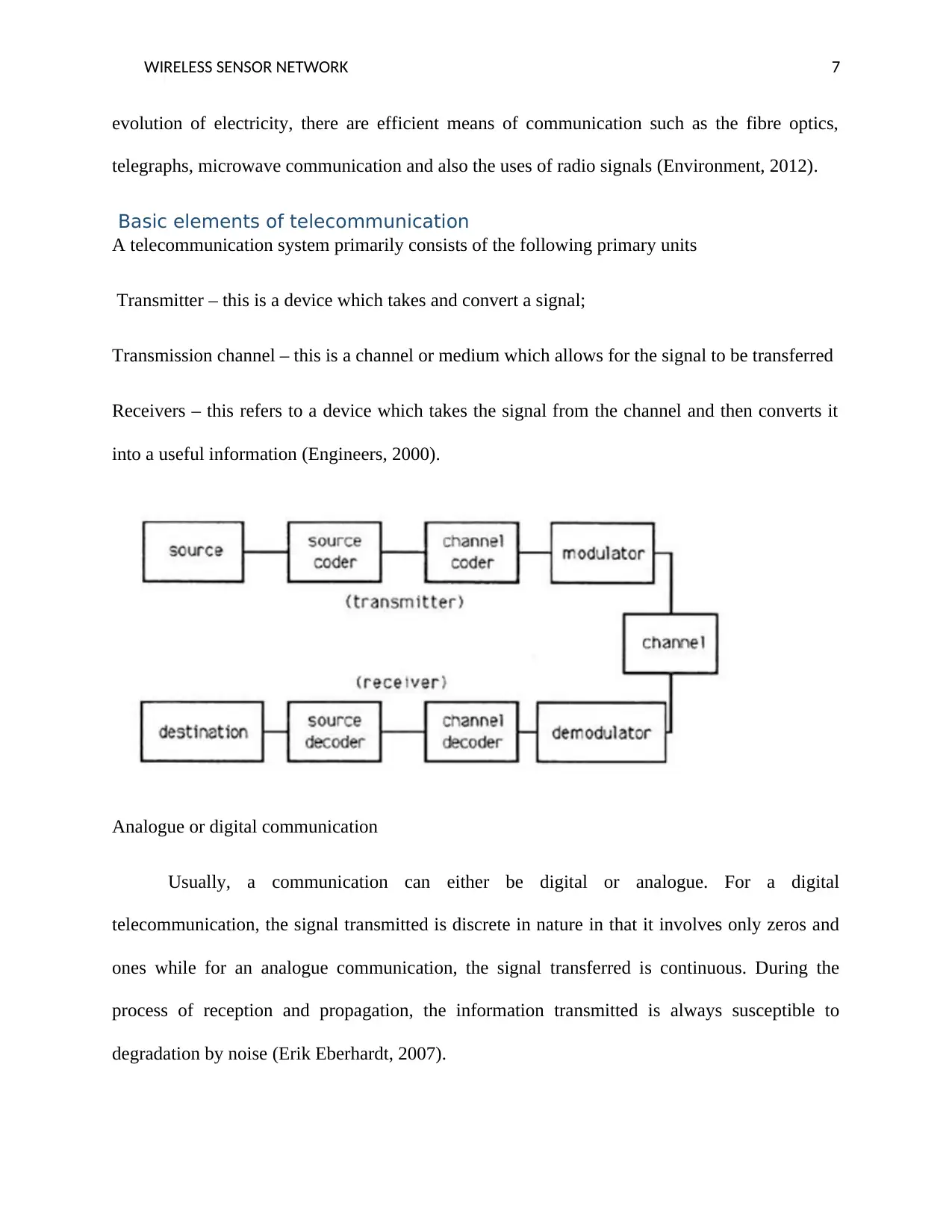
WIRELESS SENSOR NETWORK 7
evolution of electricity, there are efficient means of communication such as the fibre optics,
telegraphs, microwave communication and also the uses of radio signals (Environment, 2012).
Basic elements of telecommunication
A telecommunication system primarily consists of the following primary units
Transmitter – this is a device which takes and convert a signal;
Transmission channel – this is a channel or medium which allows for the signal to be transferred
Receivers – this refers to a device which takes the signal from the channel and then converts it
into a useful information (Engineers, 2000).
Analogue or digital communication
Usually, a communication can either be digital or analogue. For a digital
telecommunication, the signal transmitted is discrete in nature in that it involves only zeros and
ones while for an analogue communication, the signal transferred is continuous. During the
process of reception and propagation, the information transmitted is always susceptible to
degradation by noise (Erik Eberhardt, 2007).
evolution of electricity, there are efficient means of communication such as the fibre optics,
telegraphs, microwave communication and also the uses of radio signals (Environment, 2012).
Basic elements of telecommunication
A telecommunication system primarily consists of the following primary units
Transmitter – this is a device which takes and convert a signal;
Transmission channel – this is a channel or medium which allows for the signal to be transferred
Receivers – this refers to a device which takes the signal from the channel and then converts it
into a useful information (Engineers, 2000).
Analogue or digital communication
Usually, a communication can either be digital or analogue. For a digital
telecommunication, the signal transmitted is discrete in nature in that it involves only zeros and
ones while for an analogue communication, the signal transferred is continuous. During the
process of reception and propagation, the information transmitted is always susceptible to
degradation by noise (Erik Eberhardt, 2007).
Paraphrase This Document
Need a fresh take? Get an instant paraphrase of this document with our AI Paraphraser
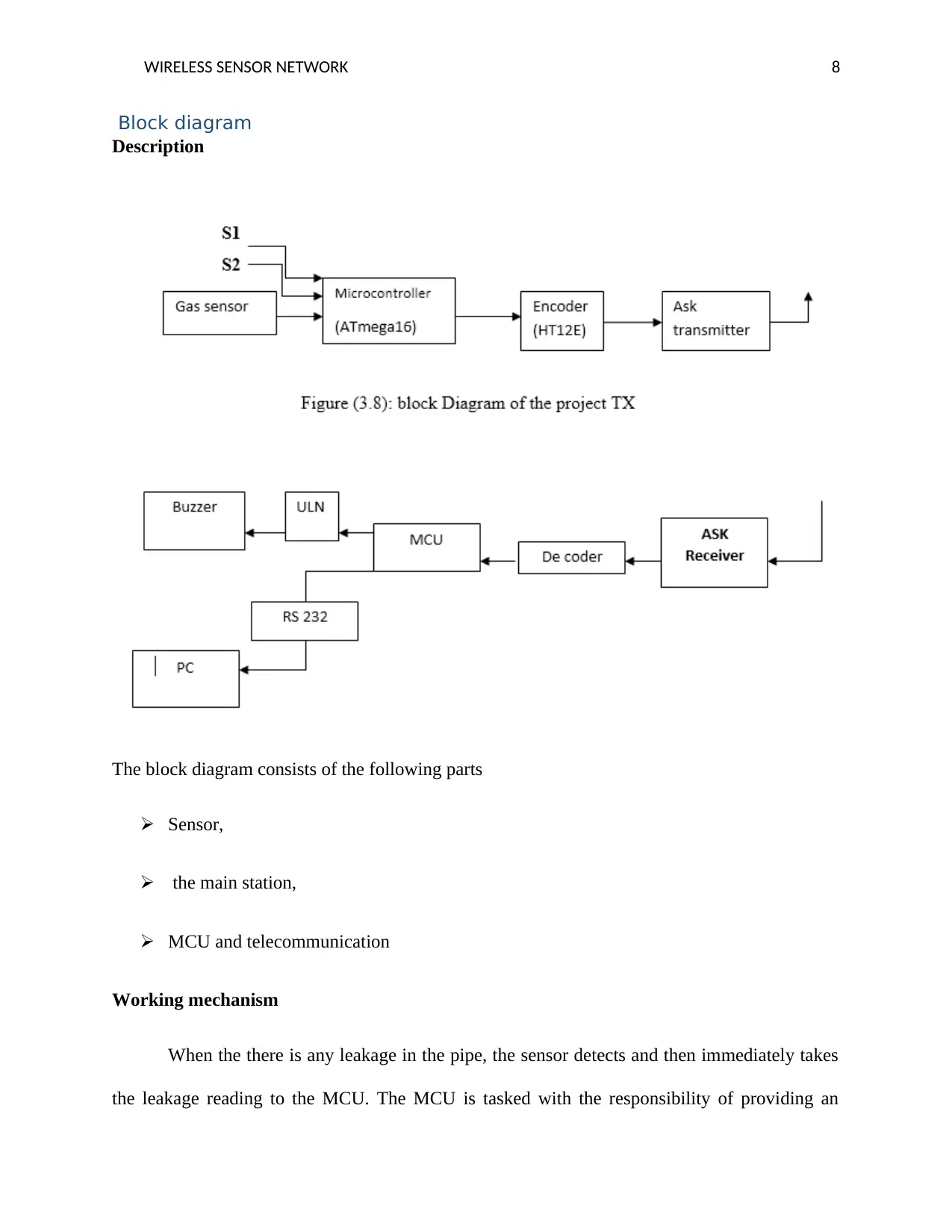
WIRELESS SENSOR NETWORK 8
Block diagram
Description
The block diagram consists of the following parts
Sensor,
the main station,
MCU and telecommunication
Working mechanism
When the there is any leakage in the pipe, the sensor detects and then immediately takes
the leakage reading to the MCU. The MCU is tasked with the responsibility of providing an
Block diagram
Description
The block diagram consists of the following parts
Sensor,
the main station,
MCU and telecommunication
Working mechanism
When the there is any leakage in the pipe, the sensor detects and then immediately takes
the leakage reading to the MCU. The MCU is tasked with the responsibility of providing an
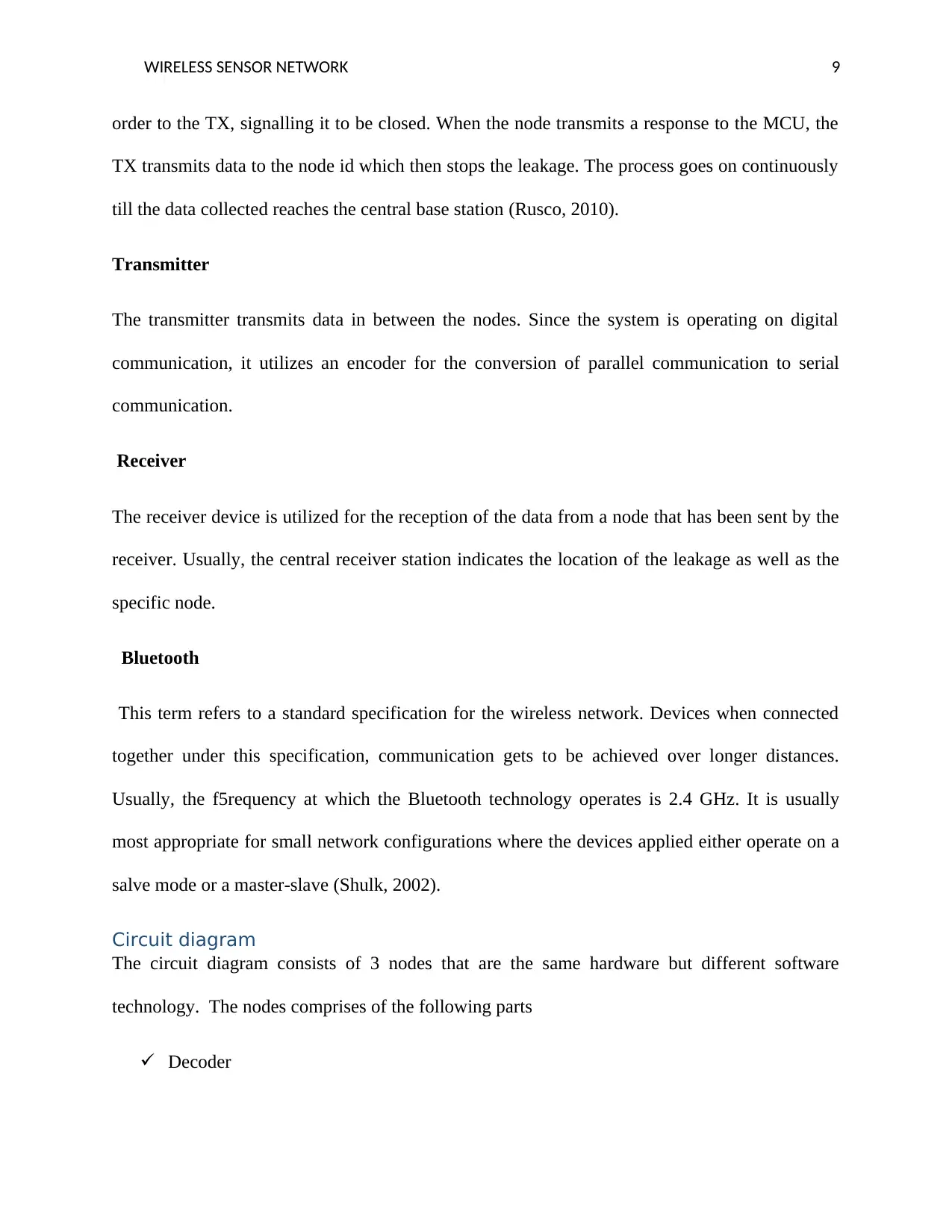
WIRELESS SENSOR NETWORK 9
order to the TX, signalling it to be closed. When the node transmits a response to the MCU, the
TX transmits data to the node id which then stops the leakage. The process goes on continuously
till the data collected reaches the central base station (Rusco, 2010).
Transmitter
The transmitter transmits data in between the nodes. Since the system is operating on digital
communication, it utilizes an encoder for the conversion of parallel communication to serial
communication.
Receiver
The receiver device is utilized for the reception of the data from a node that has been sent by the
receiver. Usually, the central receiver station indicates the location of the leakage as well as the
specific node.
Bluetooth
This term refers to a standard specification for the wireless network. Devices when connected
together under this specification, communication gets to be achieved over longer distances.
Usually, the f5requency at which the Bluetooth technology operates is 2.4 GHz. It is usually
most appropriate for small network configurations where the devices applied either operate on a
salve mode or a master-slave (Shulk, 2002).
Circuit diagram
The circuit diagram consists of 3 nodes that are the same hardware but different software
technology. The nodes comprises of the following parts
Decoder
order to the TX, signalling it to be closed. When the node transmits a response to the MCU, the
TX transmits data to the node id which then stops the leakage. The process goes on continuously
till the data collected reaches the central base station (Rusco, 2010).
Transmitter
The transmitter transmits data in between the nodes. Since the system is operating on digital
communication, it utilizes an encoder for the conversion of parallel communication to serial
communication.
Receiver
The receiver device is utilized for the reception of the data from a node that has been sent by the
receiver. Usually, the central receiver station indicates the location of the leakage as well as the
specific node.
Bluetooth
This term refers to a standard specification for the wireless network. Devices when connected
together under this specification, communication gets to be achieved over longer distances.
Usually, the f5requency at which the Bluetooth technology operates is 2.4 GHz. It is usually
most appropriate for small network configurations where the devices applied either operate on a
salve mode or a master-slave (Shulk, 2002).
Circuit diagram
The circuit diagram consists of 3 nodes that are the same hardware but different software
technology. The nodes comprises of the following parts
Decoder
⊘ This is a preview!⊘
Do you want full access?
Subscribe today to unlock all pages.

Trusted by 1+ million students worldwide
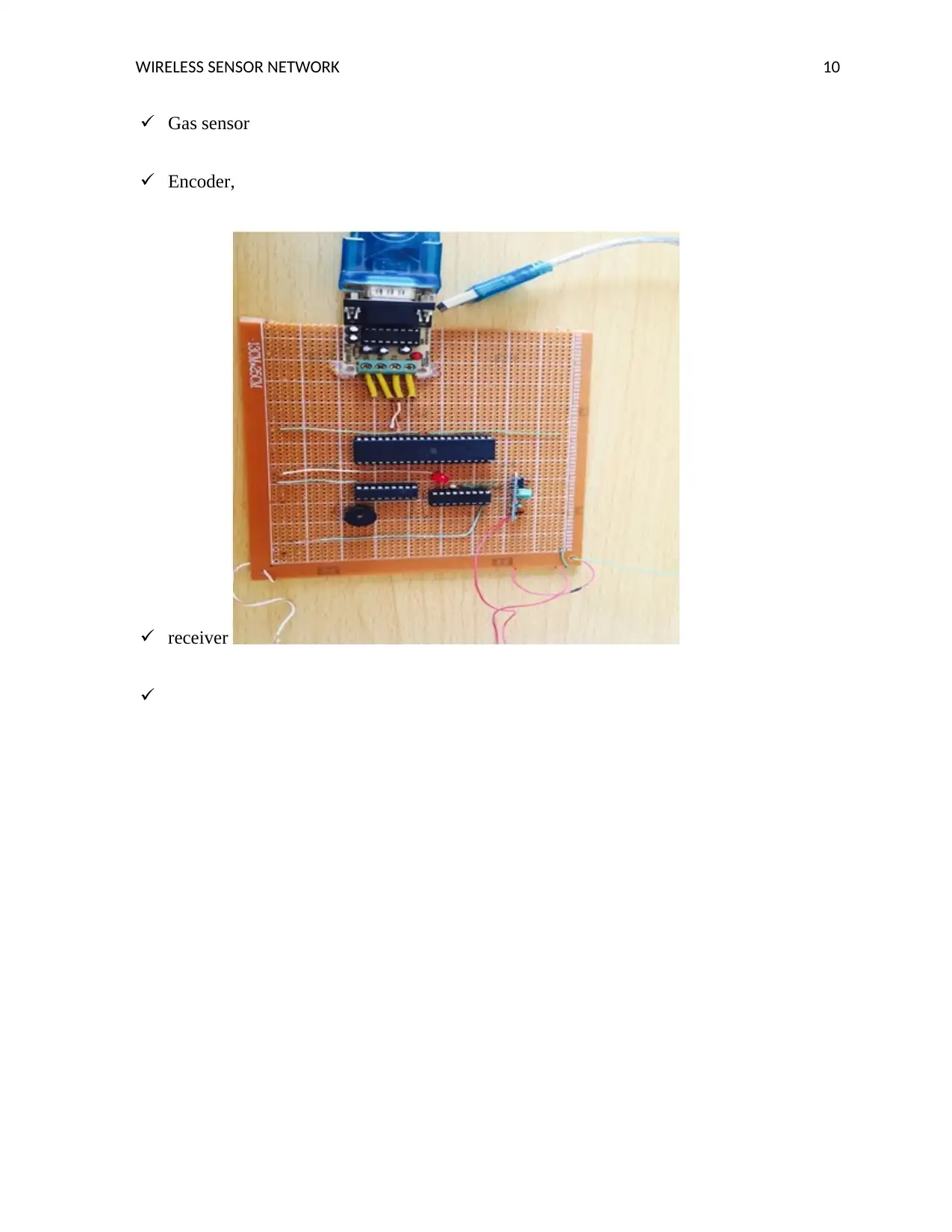
WIRELESS SENSOR NETWORK 10
Gas sensor
Encoder,
receiver
Gas sensor
Encoder,
receiver
Paraphrase This Document
Need a fresh take? Get an instant paraphrase of this document with our AI Paraphraser
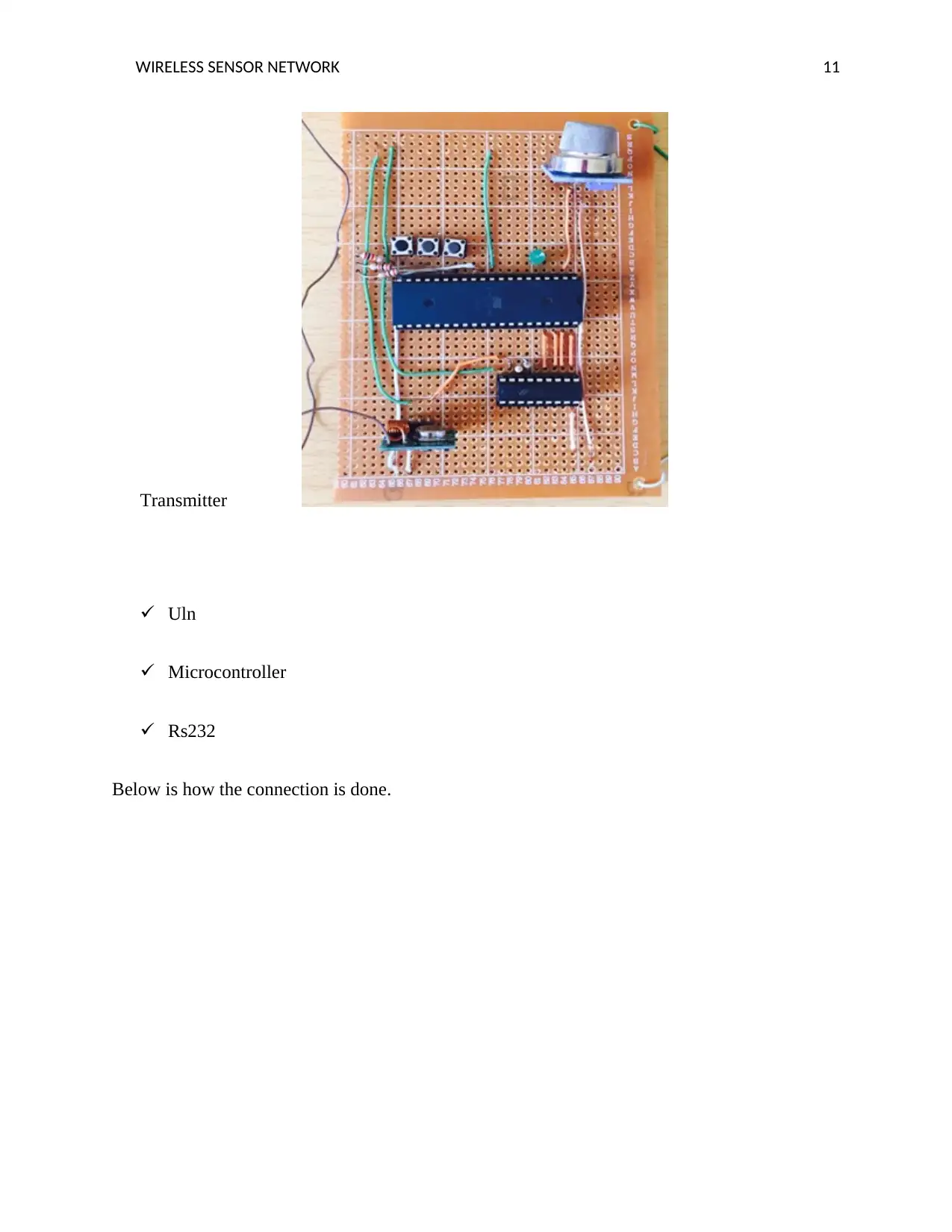
WIRELESS SENSOR NETWORK 11
Transmitter
Uln
Microcontroller
Rs232
Below is how the connection is done.
Transmitter
Uln
Microcontroller
Rs232
Below is how the connection is done.
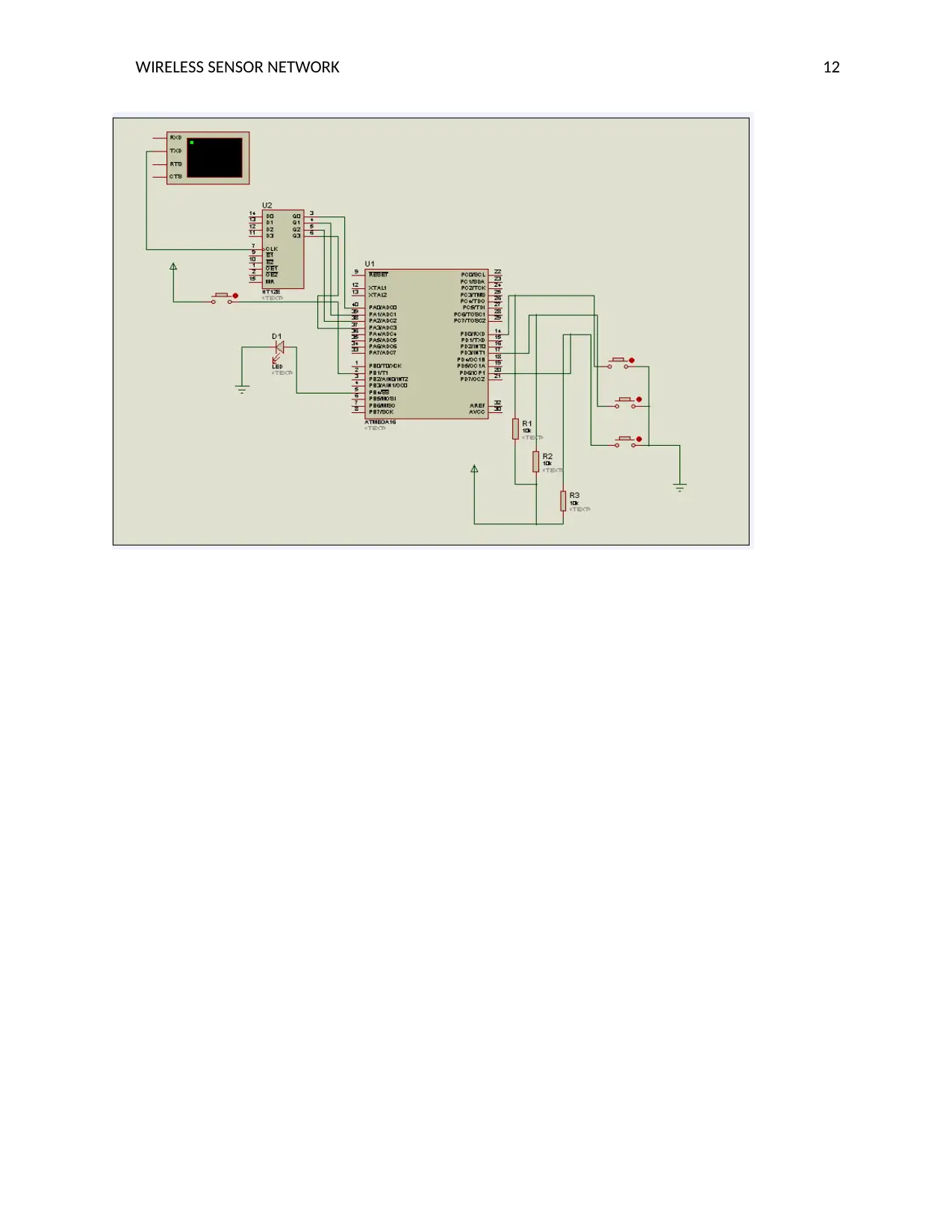
WIRELESS SENSOR NETWORK 12
⊘ This is a preview!⊘
Do you want full access?
Subscribe today to unlock all pages.

Trusted by 1+ million students worldwide
1 out of 20
Related Documents
Your All-in-One AI-Powered Toolkit for Academic Success.
+13062052269
info@desklib.com
Available 24*7 on WhatsApp / Email
![[object Object]](/_next/static/media/star-bottom.7253800d.svg)
Unlock your academic potential
Copyright © 2020–2025 A2Z Services. All Rights Reserved. Developed and managed by ZUCOL.




